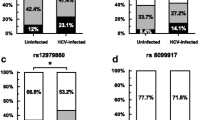Abstract
About 90% of people infected with Human T lymphotropic virus type-1 (HTLV-1) virus are asymptomatic, so it can be said that the prevalence of this virus is not completely clear. During chronic infection, the expression of programmed cell death-1 (PD-1) protein increases and causes exhausted phenotype in T cells. Considering the role of host genetics and immune responses in HTLV-1 infection, in this case–control study, included 81 asymptomatic carriers (ACs) and 162 healthy controls (HCs), rs11568821 and rs41386349 polymorphisms of PD-1 gene were evaluated by Polymerase chain reaction-restriction fragment length polymorphism (PCR-RFLP) method which investigated by one primer pair for both polymorphisms also, proviral load (PVL) measured by quantitative real-time PCR (Q-RT-PCR). The results showed that the mutant allele of rs11568821 (A) and rs41386349 (T) polymorphisms is associated with an increase in HTLV-1 infection significantly (p = 0.019 and p = 0.000 respectively). But there was no significant relationship between PVL and polymorphisms.



Similar content being viewed by others
Abbreviations
- ACs:
-
Asymptomatic carriers
- ATL:
-
Adult-T-cell Leukemia
- GAPDH:
-
Glyceraldehyde 3-phosphate dehydrogenase
- HAM:
-
HTLV-1associated myelopathy
- HBV:
-
Hepatitis B virus
- HBZ:
-
HTLV-1 basic leucine zipper protein
- HCs:
-
Healthy controls
- HCV:
-
Hepatitis C virus
- HTLV-1:
-
Human T lymphotropic virus type-1
- PBMCs:
-
Peripheral blood mononuclear cells
- PCR-RFLP:
-
Restriction fragment length polymorphism-PCR
- PD-1:
-
Programmed cell death -1
- PVL:
-
Proviral load
- RUNX-1:
-
Runt-related transcriptional factor 1
- Q-RT-PCR:
-
Quantitative real-time PCR
- TAX:
-
Transactivator protein
- Tregs:
-
Regulatory T cells
References
Ahmadi Ghezeldasht S et al (2021) HTLV-1 oncovirus-host interactions: from entry to the manifestation of associated diseases. Rev Med Virol 31(6):e2235
Arasanz H et al (2017) PD1 signal transduction pathways in T cells. Oncotarget 8(31):51936
Braz M et al (2019) Polymorphism in the interleukin-10 gene is associated with overactive bladder phenotype associated with HTLV-1 infection. Rev Soc Bras Med Trop. https://doi.org/10.1590/0037-8682-0481-2018
Ernzen KJ, Panfil AR (2022) Regulation of HTLV-1 transformation. Biosci Rep 42(3):BSR20211921
Espíndola OM et al (2021) Early effects of HTLV-1 infection on the activation, exhaustion, and differentiation of T-Cells in humanized NSG mice. Cells 10(10):2514
Forlani G et al (2021) HTLV-1 infection and pathogenesis: new insights from cellular and animal models. Int J Mol Sci 22(15):8001
Gao J et al (2017) Meta-analysis of programmed cell death 1 polymorphisms with systemic lupus erythematosus risk. Oncotarget 8(22):36885
Hashemi M et al (2019) Association between PD-1 and PD-L1 polymorphisms and the risk of cancer: a meta-analysis of case-control studies. Cancers 11(8):1150
Hezave YA et al (2022) Association of the rs4143815 polymorphism of PDL1 gene with HTLV-1 infection and proviral load in asymptomatic blood donors in northeast Iran. Microbiol Immunol 66(6):324–329
Hoffmann TW et al (2010) Association between a polymorphism in the human programmed death-1 (PD-1) gene and cytomegalovirus infection after kidney transplantation. J Med Genet 47(1):54–58
Kamoi K et al (2022) Updates on HTLV-1 uveitis. Viruses 14(4):794
Keikha M et al (2020) Molecular targeting of PD-1 signaling pathway as a novel therapeutic approach in HTLV-1 infection. Microb Pathog 144:104198
La-Roque DGL et al (2022) The expression of tax and HBZ genes in serum-derived extracellular vesicles from HTLV-1 carriers correlates to proviral load and inflammatory markers. Front Microbiol 1401
Lee Y et al (2015) Meta-analysis of genetic polymorphisms in programmed cell death 1. Z Rheumatol 74(3):230–239
Li F et al (2019) Genetic association and interaction of PD1 and TIM3 polymorphisms in susceptibility of chronic hepatitis B virus infection and hepatocarcinogenesis. Discov Med 27(147):79–92
Liu S et al (2021) RUNX1 upregulates CENPE to promote leukemic cell proliferation. Front Mol Biosci 8:692880
Matsuo M et al (2022) Identification and characterization of a novel enhancer in the HTLV-1 proviral genome. Nat Commun 13(1):2405
Moles R et al (2022) NK cells and monocytes modulate primary HTLV-1 infection. PLoS Pathog 18(4):e1010416
Parakh S et al (2021) PDCD1 polymorphisms may predict response to anti-PD-1 blockade in patients with metastatic melanoma. Front Immunol 12:672521
Ratner L et al (2018) Rapid progression of adult T-cell leukemia–lymphoma after PD-1 inhibitor therapy. N Engl J Med 378(20):1947–1948
Seliger B (2019) Basis of PD1/PD-L1 therapies. J Clin Med 8(12):2168
Thude H et al (2013) Lack of association between CTLA-4 and PDCD1 polymorphisms and acute rejection in German liver transplant recipients. Hum Immunol 74(8):1041–1045
Uchino R (2009) Domain analyses of the Runx1 transcription factor responsible for modulating T-cell receptor-β/CD4 and interleukin-4/interferon-γ expression in CD4+ peripheral T lymphocytes. Immunology 128(1):16–24
Ülger Y et al (2015) Relationship between programmed cell death-1 polymorphisms and clearance of hepatitis B virus. Int J Immunogenet 42(3):133–139
Vidal-Castiñeira JR et al (2012) A predictive model of treatment outcome in patients with chronic HCV infection using IL28B and PD-1 genotyping. J Hepatol 56(6):1230–1238
Zarei Ghobadi M et al (2021) Decoding pathogenesis factors involved in the progression of ATLL or HAM/TSP after infection by HTLV-1 through a systems virology study. Virol J 18:1–12
Zhang J et al (2016) The association between polymorphisms in the PDCD1 gene and the risk of cancer: a PRISMA-compliant meta-analysis. Medicine 95(40):e4423
Acknowledgements
We gratefully appreciate the financial and counsel support of the virology lab of High Institute for Research and Education in Transfusion Medicine, Blood Transfusion Research Center
Author information
Authors and Affiliations
Corresponding author
Additional information
Handling editor: Jody Hey.
Rights and permissions
Springer Nature or its licensor (e.g. a society or other partner) holds exclusive rights to this article under a publishing agreement with the author(s) or other rightsholder(s); author self-archiving of the accepted manuscript version of this article is solely governed by the terms of such publishing agreement and applicable law.
About this article
Cite this article
Hezave, Y.A., Sharifi, Z. & Kermani, F.R. Analysis of Programmed Cell Death-1 (PD-1) Gene Variations (re11568821 and rs41386349) in HTLV-1 Infection Using One Primer Pair and Proviral Load. J Mol Evol 91, 562–566 (2023). https://doi.org/10.1007/s00239-023-10104-5
Received:
Accepted:
Published:
Issue Date:
DOI: https://doi.org/10.1007/s00239-023-10104-5




